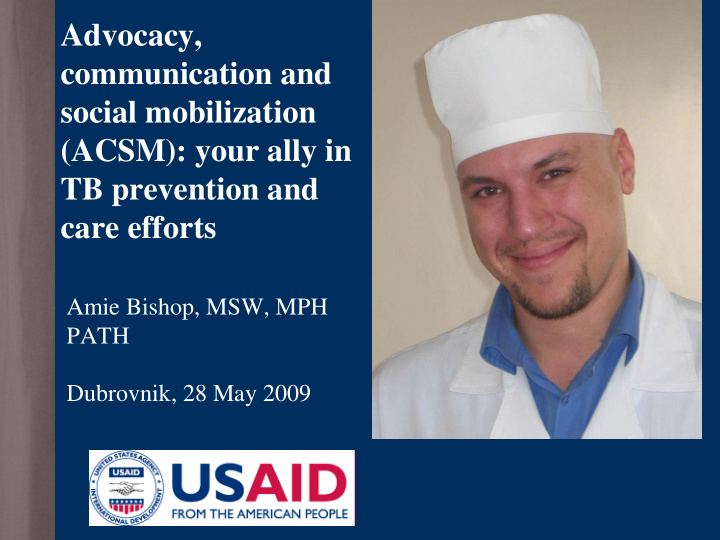



Advocacy, communication and social mobilization (ACSM): your ally in TB prevention and care efforts Amie Bishop, MSW, MPH PATH Dubrovnik, 28 May 2009
Challenges to TB Control in the Region • Socioeconomic crises-past and All of these can be present addressed by ACSM! • Inefficient services and poor funding • Slow adoption of DOTS • Disaffected health care staff • Poor drug use practices (providers and patients); emergence of MDR-TB • Lack of effective educational strategies • HIV epidemic emerging • Stigma and discrimination • Weak or struggling civil society- TB patients have few advocates • Poor social support for vulnerable populations
What is ACSM? Advocacy (A) • Building political commitment and influencing policymakers to ensure sustainable financial support, policies, and other resources Example: advocacy to ensure ministerial orders, funding allocations, and policies support the WHO European Regional Plan to Stop TB
What is ACSM (2) Communication (C) • Improving TB-related awareness, knowledge and attitudes and encouraging positive behavior change to increase the likelihood of early detection and treatment success. • Improving interpersonal communication and counseling between patients and program providers.
Communication examples Training providers on communication skills to improve client-provider relationships
ACSM (3) Social Mobilization (SM) • Community engagement and action to ensure sustainability, self-reliance, and integration of TB control into overall community priorities. • Influencing social norms and creating more favorable environments in which affected communities can have a role in guiding TB control interventions.[1] [1] World Health Organization. Advocacy, Communication, and Social Mobilization (ACSM) for Tuberculosis Control: A Handbook for Country Programs. WHO/HTM/STB; 2007.
Stigma and discrimination • Stigma greatest barrier to care for people with HIV and/or TB – HIV associated with drug use, sex work – TB associated with prisons, alcoholism, homelessness • Providers unsupported, lack information
ACSM is interlinked C SM A
Challenges • Socioeconomic crises-past and present Advocacy Inefficient services and poor funding • • Slow adoption of DOTS • Disaffected health care staff • Poor drug use practices (providers and patients); emergence of MDR-TB • Lack of effective educational strategies Communication • HIV epidemic emerging Stigma and discrimination • • Weak or struggling civil society-TB patients have few advocates Social Mobilization • Poor social support for vulnerable populations
Strategic Planning and Evaluation Satisfaction with Doctors' Explanation of ACSM objectives must be: TB Treatment Options N=312 (10 facilities in Kyiv and Donetsk, 2004) • Data driven (needs 60% 51% assessments through 50% 37% 40% 34% surveys, interviews, 26% Donetsk 30% 22% Kyiv 15% 15% focus groups, 20% 10% 1% observation, etc) 0% Very dissatisfied Dissatisfied Satisfied Very satisfied • Measurable and achievable • Tied to overall TB control program goals
The Power of ACSM • Mobilizing political commitment and resources for TB. • Improving case- finding and treatment adherence. • Combating stigma and discrimination. • Empowering people affected by TB.
Amie Bishop, MSW, MPH abishop@path.org www.path.org
Recommend
More recommend